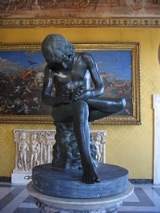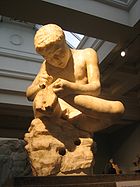
Boy with Thorn
Encyclopedia

Rome
Rome is the capital of Italy and the country's largest and most populated city and comune, with over 2.7 million residents in . The city is located in the central-western portion of the Italian Peninsula, on the Tiber River within the Lazio region of Italy.Rome's history spans two and a half...
. A Roman marble of this subject from the Medici
Medici
The House of Medici or Famiglia de' Medici was a political dynasty, banking family and later royal house that first began to gather prominence under Cosimo de' Medici in the Republic of Florence during the late 14th century. The family originated in the Mugello region of the Tuscan countryside,...
collections is in a corridor of the Uffizi Gallery, Florence
Florence
Florence is the capital city of the Italian region of Tuscany and of the province of Florence. It is the most populous city in Tuscany, with approximately 370,000 inhabitants, expanding to over 1.5 million in the metropolitan area....
.
The sculpture was one of the very few Roman bronzes that was never lost to sight. It was standing outside the Lateran Palace
Lateran Palace
The Lateran Palace , formally the Apostolic Palace of the Lateran , is an ancient palace of the Roman Empire and later the main Papal residence....
when the Navarrese rabbi Benjamin of Tudela
Benjamin of Tudela
Benjamin of Tudela was a medieval Jewish traveler who visited Europe, Asia, and Africa in the 12th century. His vivid descriptions of western Asia preceded those of Marco Polo by a hundred years...
saw it in the 1160s and identified it as Absalom, who "was without blemish from the sole of his foot to the crown of his head." It was noted in the late twelfth or early thirteenth century by the English visitor, Magister Gregorius, who noted in his De mirabilibus urbis Romae
De mirabilibus urbis Romae
De mirabilibus urbis Romae, preserved in a single manuscript, is a medieval guide in Latin to the splendors of Rome, which was written in the mid-twelfth century by a certain Magister Gregorius of Oxford. The outlook here is even more secular than the Mirabilia Urbis Romae, Roberto Weiss noted...
that it was ridiculously thought to be Priapus
Priapus
In Greek mythology, Priapus or Priapos , was a minor rustic fertility god, protector of livestock, fruit plants, gardens and male genitalia. Priapus is marked by his absurdly oversized, permanent erection, which gave rise to the medical term priapism...
. It must have been one of the sculptures transferred to the Palazzo dei Conservatori by Pope Sixtus IV
Pope Sixtus IV
Pope Sixtus IV , born Francesco della Rovere, was Pope from 1471 to 1484. His accomplishments as Pope included the establishment of the Sistine Chapel; the group of artists that he brought together introduced the Early Renaissance into Rome with the first masterpiece of the city's new artistic age,...
in the 1470s, though it is not recorded there until 1499-1500. It was celebrated in the Early Renaissance, one of the first Roman sculptures to be copied: there are bronze reductions by Severo da Ravenna and Jacopo Buonaccolsi
Pier Jacopo Alari Bonacolsi
Pier Jacopo Alari Bonacolsi , called "L'Antico" by his contemporaries for the refined interpretation of the Antique they recognized in his work, was a 16th century North Italian sculptor, known for his finely detailed small bronzes all'Antica—coolly classicizing, often with gilded details,...
, called "L'Antico" for his refined classicizing figures: he made a copy for Isabella d'Este
Isabella d'Este
Isabella d'Este was Marchesa of Mantua and one of the leading women of the Italian Renaissance as a major cultural and political figure. She was a patron of the arts as well as a leader of fashion, whose innovative style of dressing was copied by women throughout Italy and at the French court...
about 1501 and followed it with an untraced pendant that perhaps reversed the pose. For a fountain of 1500 in Messina, Antonello Gagini
Antonello Gagini
Antonello Gagini was an Italian sculptor of the Renaissance, mainly active in Sicily and Calabria.Antonello was a member of a family of sculptors and artisans, originally from Northern Italy, but active throughout Italy, including Genoa, Florence, and Rome. The family includes his father, Domenico...
made a full-size variant, probably the bronze that is now in the Metropolitan Museum of Art
Metropolitan Museum of Art
The Metropolitan Museum of Art is a renowned art museum in New York City. Its permanent collection contains more than two million works, divided into nineteen curatorial departments. The main building, located on the eastern edge of Central Park along Manhattan's Museum Mile, is one of the...
, New York.

Francis I of France
Francis I was King of France from 1515 until his death. During his reign, huge cultural changes took place in France and he has been called France's original Renaissance monarch...
, the gift came from Ippolito II d'Este
Ippolito II d'Este
Ippolito d'Este was an Italian cardinal and statesman. He was a member of the House of Este, and nephew of the other Ippolito d'Este, also a cardinal.-Biography:...
; his copy was overseen by Giovanni Fancelli and Jacopo Sansovino
Jacopo Sansovino
Jacopo d'Antonio Sansovino was an Italian sculptor and architect, known best for his works around the Piazza San Marco in Venice. Andrea Palladio, in the Preface to his Quattro Libri was of the opinion that Sansovino's Biblioteca Marciana was the best building erected since Antiquity...
, and the transaction effected by the courtly Benvenuto Cellini
Benvenuto Cellini
Benvenuto Cellini was an Italian goldsmith, sculptor, painter, soldier and musician, who also wrote a famous autobiography. He was one of the most important artists of Mannerism.-Youth:...
. For Philip II of Spain
Philip II of Spain
Philip II was King of Spain, Portugal, Naples, Sicily, and, while married to Mary I, King of England and Ireland. He was lord of the Seventeen Provinces from 1556 until 1581, holding various titles for the individual territories such as duke or count....
, the copy was the gift of Cardinal Giovanni Ricci. In the following century Charles I of England
Charles I of England
Charles I was King of England, King of Scotland, and King of Ireland from 27 March 1625 until his execution in 1649. Charles engaged in a struggle for power with the Parliament of England, attempting to obtain royal revenue whilst Parliament sought to curb his Royal prerogative which Charles...
had a bronze Spinario by Hubert Le Sueur
Hubert Le Sueur
Hubert Le Sueur was a French sculptor with the contemporaneous reputation of having trained in Giambologna's Florentine workshop, who assisted Giambologna's foreman, Pietro Tacca, in Paris, finishing and erecting the equestrian statue of Henri IV on the Pont Neuf...
(Haskell and Penny 1981: 308).
Small bronze reductions were suitable for the less grand. A Still Life with 'Spinario by Pieter Claesz
Pieter Claesz
Pieter Claesz was a Dutch Golden Age still life painter.-Biography:He was born in Berchem, Belgium, near Antwerp, where he became a member of the Guild of St. Luke in 1620. He moved to Haarlem in 1621, where his son, the landscape painter Nicolaes Pieterszoon Berchem was born...
, 1628, is conserved at the Rijksmuseum
Rijksmuseum
The Rijksmuseum Amsterdam or simply Rijksmuseum is a Dutch national museum in Amsterdam, located on the Museumplein. The museum is dedicated to arts, crafts, and history. It has a large collection of paintings from the Dutch Golden Age and a substantial collection of Asian art...
; among the riches emblemmatic of the good life, it displays a small plaster model of the Spinario.
There were also marble copies. The Medici Roman marble seems to have been among the collection of antiquities assembled in the gardens at San Marco, Florence, which were the resort of the humanists in the circle of Lorenzo il Magnifico, who opened his collection to young artists to study from. The young Michelangelo
Michelangelo
Michelangelo di Lodovico Buonarroti Simoni , commonly known as Michelangelo, was an Italian Renaissance painter, sculptor, architect, poet, and engineer who exerted an unparalleled influence on the development of Western art...
profited from this early exposure to antique sculpture, and it has been discussed whether Masaccio
Masaccio
Masaccio , born Tommaso di Ser Giovanni di Simone, was the first great painter of the Quattrocento period of the Italian Renaissance. According to Vasari, Masaccio was the best painter of his generation because of his skill at recreating lifelike figures and movements as well as a convincing sense...
was influenced by the Medici Spinario or by the bronze he saw in Rome in the 1420s,, but Filippo Brunelleschi
Filippo Brunelleschi
Filippo Brunelleschi was one of the foremost architects and engineers of the Italian Renaissance. He is perhaps most famous for inventing linear perspective and designing the dome of the Florence Cathedral, but his accomplishments also included bronze artwork, architecture , mathematics,...
more certainly adapted the Spinarios pose for the left-hand attendant in the bronze competition panel, The Sacrifice of Isaac 1401, his trial piece for the doors of the Baptistery of San Giovanni
Battistero di San Giovanni (Florence)
The Florence Baptistry or Battistero di San Giovanni is a religious building in Florence , Italy, which has the status of a minor basilica....
.
The formerly popular title Il Fedele ("The faithful boy") derived from an anecdote invented to give this intimate and naturalistic study a more heroic civic setting: the faithful messenger, a mere shepherd boy, had delivered his message to the Roman Senate first, only then stopping to remove a painful thorn from his foot: the Roman Senate commemorated the event. Such a story was already deflated in Paolo Alessandro Maffei's Raccolta di statue antiche e moderni... of 1704
Recent scholarship, taking into account Hellenistic marble variants that have been discovered, of which the best is the Thorn-Puller from the Castellani collection, now in the British Museum
British Museum
The British Museum is a museum of human history and culture in London. Its collections, which number more than seven million objects, are amongst the largest and most comprehensive in the world and originate from all continents, illustrating and documenting the story of human culture from its...
, none of which have the archaizing qualities of the bronze Spinario, has tended to credit this as a Roman bronze of the first century CE, with a head adapted from an archaic prototype.
External links
- Guida Artistica di Firenze: Sculture Antiche Illustrates the Roman marble Spinario in the Uffizi
- Johannes Röll, "The Census of Antique Works of Art and Architecture Known in the Renaissance" Section on the Spinario ("Dornauszieher").

